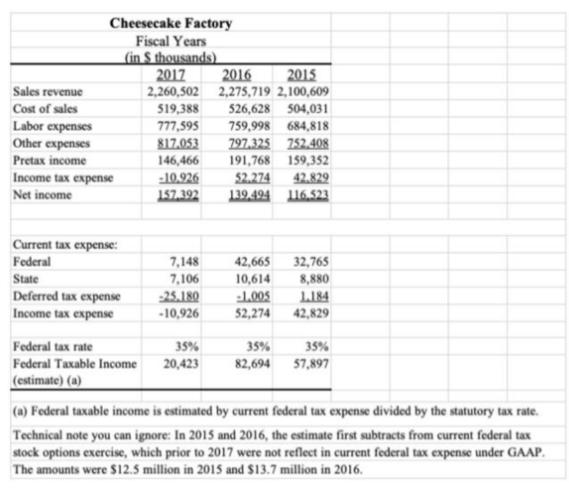Question
You are an advisor to The Cheesecake Factory. It is late December 2017, and you are dining with their executive team at one of their
You are an advisor to The Cheesecake Factory. It is late December 2017, and you are dining with their executive team at one of their restaurants, celebrating a successful year. As you take another bite of delicious cheesecake, their CFO asks you for your thoughts on the recently enacted corporate tax legislation.
The CFO is referring to the Tax Cuts and Jobs Act (TCJA), which you've heard is a major tax overhaul.
While you are not a tax specialist, you quickly recall some key changes from the TCJA and apply principles you learned.
The key tax changes you recall are:
- The corporate tax rate will go from 35% to 21%.
- Tax depreciation will become much more favorable, with a lot of capital expenditures (i.e., purchases of equipment but not real estate) becoming eligible for immediate expensing for tax purposes.
- The net operating loss rules will change from a 2-year carryback period to no carrybacks, and from a 20-year carryforward period to no limit on the carryforward period.
- The effective date will be January 1, 2018.
You know the company expects to be profitable in 2018, with sales and expenses growing at roughly the same pace as the past couple years. Having spent a lot of time with their financials, you have a basic recollection of the following:

You begin to formulate your response. You recall that one of the four kinds of income tax planning is shifting income over time from a high tax rate year to a low tax rate year.
1. Is there any incentive for The Cheesecake Factory in 2017 to shift income? If so, what is the incentive?
2. How might The Cheesecake Factory shift income or expenses? Be as specific as possible.
3. What are tax benefits of the income shifting you consider?
4. What are the tax and nontax costs of the income shifting you consider?
Sales revenue Cost of sales Cheesecake Factory Fiscal Years (in S thousands) Labor expenses Other expenses Pretax income Income tax expense Net income Current tax expense: Federal State Deferred tax expense Income tax expense Federal tax rate Federal Taxable Income (estimate) (a) 2017 2,260,502 519,388 777,595 817.053 146,466 -10.926 157.392 7,148 7,106 -25.180 -10,926 35% 20,423 2016 2015 2,275,719 2,100,609 526,628 504,031 759,998 684,818 797.325 752.408 191,768 159,352 52.274 42.829 139.494 116.523 42,665 32,765 10,614 8,880 -1.005 52,274 35% 82,694 1.184 42,829 35% 57,897 (a) Federal taxable income is estimated by current federal tax expense divided by the statutory tax rate. Technical note you can ignore: In 2015 and 2016, the estimate first subtracts from current federal tax stock options exercise, which prior to 2017 were not reflect in current federal tax expense under GAAP. The amounts were $12.5 million in 2015 and $13.7 million in 2016.
Step by Step Solution
3.34 Rating (145 Votes )
There are 3 Steps involved in it
Step: 1
1 The incentive for The Cheesecake Factory to shift income from 2017 to 2018 is primarily based on t...
Get Instant Access to Expert-Tailored Solutions
See step-by-step solutions with expert insights and AI powered tools for academic success
Step: 2

Step: 3

Ace Your Homework with AI
Get the answers you need in no time with our AI-driven, step-by-step assistance
Get Started


